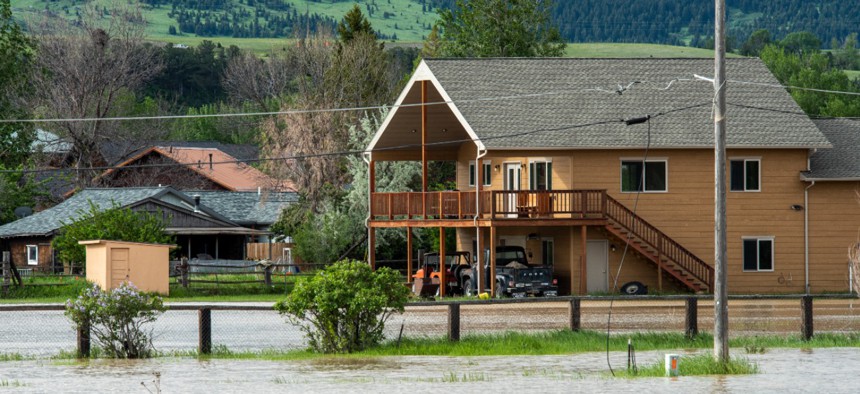
Flooding is seen on June 14 in Livingston, Mont. The Yellowstone River had hit a historic high flow from rain and snow melt from the mountains in and around Yellowstone National Park. William Campbell/Getty Images
More Help Is On the Way for Feds With TSP Transition Troubles, and Those Affected By Flooding
A weekly roundup of pay and benefits news.
The past month has been a rocky ride for participants in the federal government’s 401(k)-style retirement savings program, who were hit not only by losses in the financial markets but also by glitches in the June 1 transition to a new recordkeeper.
More than a month after the transition, the Thrift Savings Plan continues to face a high volume of calls to its Thrift Line, Kim Weaver, director of external affairs for the Federal Retirement Thrift Investment Board, said on Wednesday. The good news, though, for participants trying to get through to a representative who can answer their questions, is that by Friday the staff at the helpline will have nearly doubled, jumping from 485 on June 1 to an anticipated 955 (there were already 805 contact center representatives as of June 21).
The recently hired agents will need some time to be trained before they answer their first call, Weaver cautioned. The new recordkeeper offers a number of benefits such as a more secure login process and access to 5,000 mutual funds, but many participants initially had trouble with the basic steps needed to take advantage of these features, such as setting up their accounts.
The TSP executive director has agreed to brief Del. Eleanor Holmes Norton, D-D.C., weekly on the status of the recordkeeper transition and will update other concerned lawmakers on an ad hoc basis, Weaver said.
“I am pleased Director [Ravindra] Deo accepted my request to be sent weekly updates,” Norton said in a statement. “My constituents and federal employees and retirees across the country continue to face many problems with the new system, including taxes being erroneously taken from accounts, incorrect beneficiary information, and inability to access their retirement savings.”
Since June 1, there have been 1.2 million unique TSP participants who have logged into the new system, Weaver said. About 3.3 million participants—or half of all participants—log onto My Account in a typical year.
An Extension of Special Hiring Rules for COVID Response
The Office of Personnel Management on June 27 extended the use of special hiring authorities to help bring on employees for the government’s COVID-19 pandemic response. The memo from OPM Director Kiran Ahuja to agency heads allows hiring officials to continue using excepted service Schedule A hiring authority to fill temporary jobs directly related to the pandemic until March 1, 2023.
Schedule A allows agencies to bypass standard competitive hiring procedures to find people faster and more efficiently. For instance, agencies need not post the vacancy publicly on USAJobs.gov (though they can still do so if they would like).
“OPM understands that during this time, agencies continue to need more tools to conduct strategic, targeted hiring for specific, short-term roles to meet mission and/or hiring needs,” Ahuja wrote. “OPM has determined that the continued use of this special authority is justified, as agencies have on-going responsibilities directly related to the COVID-19 pandemic.”
The special hiring rules apply for temporary appointments of up to one year in positions directly involved in COVID-19 response. Hires made before the cutoff date can be extended up to one additional year.
OPM has released a fact sheet with more information on use of the special hiring authority.
Help for Flooding Victims
OPM has announced a leave donation program to help federal employees and their family members affected by the severe storms and flooding in Montana. Heavy rainfall combined with melting snow caused significant flooding in June that damaged Yellowstone National Park and surrounding areas, forcing rescues, evacuations and closures.
This emergency leave transfer program will help flooding victims take additional time off to recover from flooding that happened June 10 or later in the Carbon, Park and Stillwater counties of Montana, without having to dip into their own paid leave. OPM left it up to individual agencies to assess their needs and set up donation programs if they have employees affected by the storms and flooding.
“Agencies with employees affected by the disaster are in the best position to determine whether, and how much donated annual leave is needed by their employees and which of their employees have been adversely affected by the specific emergency within the meaning of OPM regulations,” stated the July 1 memo from Ahuja to agency heads. “They are also in the best position to quickly facilitate the transfer of annual donated leave within their agencies.”
Officials can also contact other federal agencies for help if they do not have enough donated leave internally to cover their needs.
Employees who wish to donate leave should contact their agency rather than OPM, and those who need help should contact their agencies in writing.







